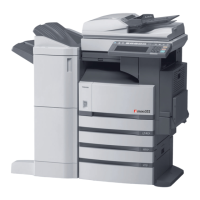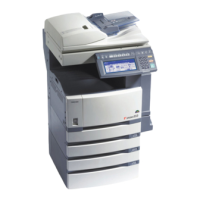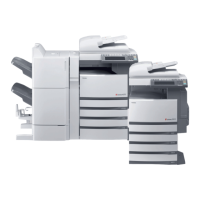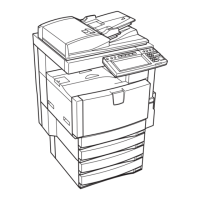
Do you have a question about the Toshiba e-STUDIO355 and is the answer not in the manual?
| Brand | Toshiba |
|---|---|
| Model | e-STUDIO355 |
| Category | All in One Printer |
| Language | English |
Detailed specifications of the e-STUDIO series, including type, glass, process, fixing method, etc.
Details the procedure to check the status of various input signals using the test mode, listing specific buttons and their functions.
Explains how to check the status of output signals by inputting specific codes in the test mode (03).
Explains how to adjust various items and change settings within the Adjustment Mode (05) using specific procedures.
Details how to set or change various items listed in the Setting Mode (08) through specific operational procedures.
Provides a step-by-step procedure for adjusting the auto-toner sensor, especially after replacing the developer material.
Details procedures for adjusting image dimensions, including paper alignment, printer, and scanner-related adjustments.
Explains how to adjust image quality parameters for copying, such as gamma balance and density.
Explains the procedures and precautions for adjusting outputs related to the high-voltage transformer, including biases and chargers.
Explains the data cloning function for backing up and restoring user data, settings, and SRAM data to a USB media.
Details the procedure for setting up the AES data encryption function on the HDD to enhance security.
Explains the functionality of the PM support mode for viewing part usage, replacement records, and counter clearing.
Details the operation flow for replacing EPUs (drum/cleaner, developer) and the necessary subsequent adjustments.
Explains how to use the chapter to solve troubles, starting with checking error codes on the control panel.
Lists various error codes displayed on the screen, their classification, contents, and corresponding troubleshooting page numbers.
Provides detailed diagnostic steps and prescriptions for resolving specific error codes related to paper jams and system calls.
Offers troubleshooting steps for common image quality problems like density abnormalities, background fogging, moire, and blurred images.
Provides essential precautions and procedures for replacing PC boards and the HDD, emphasizing replacing one board at a time.
Explains how to update firmware using USB media, including necessary programs and file structures.
Provides procedures and troubleshooting steps to follow when firmware updating fails, including checking USB media and board connections.
Explains the Auto Supply Order function, which automatically orders toner via FAX or E-mail based on usage counts.











